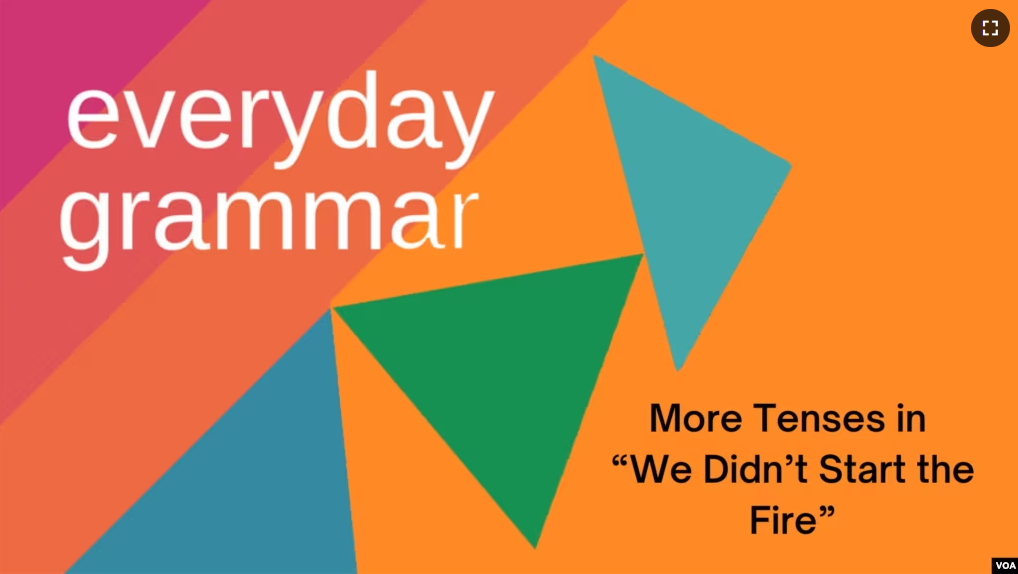In today’s Everyday Grammar, we finish our discussion of Fallout Boy’s remake of the song We Didn’t Start the Fire, which was written and performed by Billy Joel.
The new version of the song lists historical events from 1989 to the present, but the chorus is the same as Billy Joel’s 1989 version. Today, we will look at verbal tenses in that part of the song.
Lyrics and the meaning
We didn’t start the fire
It was always burning since the world’s been turning
We didn’t start the fire
No, we didn’t light it but we’re trying to fight it
The “fire” can be understood as bad things happening in the world. The song is talking about how bad things have existed throughout history and that one generation is not responsible for all of them. Joel was saying that his generation was doing its best to help by trying to fight “the fire.”
Let’s move on to verbal tenses in the chorus.
Verbal tenses in the chorus
In the chorus, the simple past tense in the negative is used in the 1st person plural or “we” form.
To form the negative simple past, we use:
Subject + did + not + base verb + the rest of the sentence.
In the song, the contraction of “did not” is used, “didn’t.”
We didn’t start the fire.
No, we didn’t light it…
Next, we see the past continuous tense in the 3rd person singular form. The past continuous is used to talk about ongoing things that happened in the past.
It was always burning…
To form the past continuous, we use:
Subject + past tense form of be (was or were) + base verb and present participle (-ing ending) + the rest of the sentence
It was always burning since the world’s been turning.
In the second half of that sentence, we have a clause starting with “since” in the present perfect continuous. The present perfect continuous is used to talk about things that started in the past and are continuing today.
To form the present perfect continuous, we use:
Subject + has been or have been + base verb and present participle (-ing ending) + the rest of the sentence or clause
…since the world has been turning…
The contraction form is used in the song. In everyday English “has” sometimes appears as apostrophe “s” (‘s).
…since the world’s been turning…
And lastly, we see the present continuous tense used in the second half of the last line of the chorus. It is in the first person plural using “we” in a contraction with “are.”
No, we didn’t light it, but we’re trying to fight it
The present continuous tense is used to talk about actions that are happening now, occurring often and may continue into the future.
To form the present continuous, we use:
Subject + be (am, is, are) + base verb and present participle (-ing ending) +the rest of the sentence.
In the final chorus of the song, there is a conditional statement:
But when we are gone,
It will still go on…
This is a type one or first conditional. This type of conditional is used to talk about future situations that are possible or real.
The structure of type one conditionals is:
If or when + present simple tense verb, will + infinitive verb.
The word “gone” is a past participle adjective. This sentence means that the world will continue when this generation is no more.
Final thoughts
In today’s Everyday Grammar, we closely examined other verbal tenses in the chorus of the song We Didn’t Start the Fire. There were the past and present continuous tenses, the present perfect continuous and the simple past tense. We even talked about first conditional statements. Next time you are listening to a song, try to see which tenses are used or if there are any conditional statements.
I’m Faith Pirlo.
Faith Pirlo wrote this lesson for VOA Learning English.
_____________________________________________
Words in This Story
chorus – n. part of a song that is repeated
tense – n. grammar: a form of a verb that is used to show when an action happened
contraction – n. grammar: a shortened form of a word
conditional – n. grammar: showing or used to show that something is true or happens only if something else is true or happens
infinitive verb – n. grammar: the basic form of a verb with the word “to”
